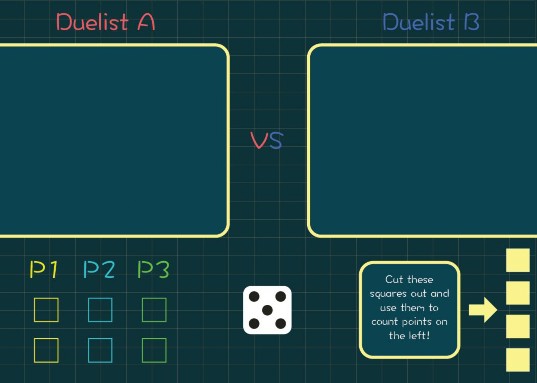Codesigning Games with Students through a Pandemic - Part 2
By Adrian Ma, with foreword and edits by Jesse Flot
Foreword
The following article serves as a journal entry from CMU Game Design student Adrian Ma as they explore codesign with K12-aged students through the Player-Programmed Partner Games (P3G) project, under COVID-19 restrictions. P3G is an Innovations in Development project that seeks to increase access to informal STEM education in out-of-school time settings, while simultaneously bringing the human-robotics interaction paradigms of robotics education up-to-date. Under COVID-19 restrictions, researchers developed and utilized "Coboxes". These literal boxes contained prompts and game design resources to educate the K12-aged students in subjects of cobots and game design while simultaneously soliciting their input for the design of new digital games.
Codesign Journal Entry
To understand the coboxes we would be developing, we first researched the purpose and use of cultural probes in a variety of social contexts. We learned about common probing techniques such as opening with easy tasks for greater engagement and realized the effectiveness of probes that asked about the future. With this knowledge, I brainstormed some probes of my own. Here are a couple of them:
-
If you could visit any place in the universe in our game, real or imaginary, where would you go?
Draw a picture of this place and tell us what you would want to do there.
-
You have been selected to build a house for a new family. You have the choice of hiring a cobot friend to help you, or you can build the house on your own. Build a model of what this house will look like using legos.
-
If you could travel to the future and visit any place in the universe, where would you go? Create this world and draw us a picture of it! Tell us why you want to go there.
-
A family has decided to move into your world and you need to build a house for them! You can hire a cobot friend of your choice to help you, or you can build the house on your own. Build a model of what the house will look like after you (and maybe a cobot) finish working on it using the legos in your cobox.
-
Path 1 (house w/ cobot) If you hired a cobot to help you build a house, what would the cobot look like? Make a model of this cobot using the legos in your cobox. Tell us what it can do!
-
Path 2 (house w/o cobot) Inside of your world, if you had a cobot friend to help you with everyday life, what would they look like? Build us your cobot using the legos in your cobox and tell us what it can do.
-
What kind of games or sports would people play in your world? Would you be able to play it with or against cobots? Try to reenact your cobot (from probe 3) playing this game using the materials in your cobox. Take a picture of this and tell us about the game!
-
Your cobot has decided to come back to the real world and live with you! How would this cobot help you in your present day life? Take a picture of you with your cobot doing a task that neither of you would be able to do alone.
With the first cobox of the project nearing completion, we took a step back to look at the bigger picture and thought about roadmaps for our boxes. These roadmaps plan out what each box in our series of boxes would focus on and considers relationships between them. I identified three main focuses: game design, child-cobot relationship, and cobot image.
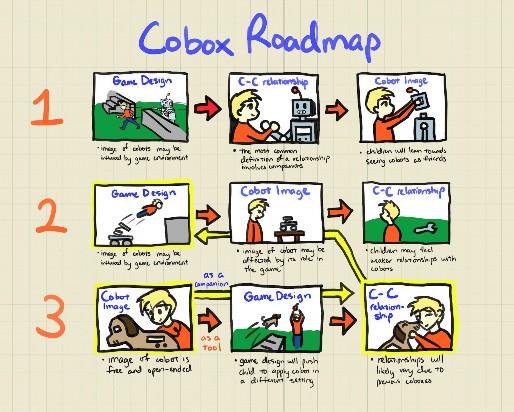
By creating these roadmaps, we learned a lot about how the order in which children completed probes affected their formation of ideas and about what else we needed to learn from the following coboxes. With these relationships in mind, we created an idea for the second cobox. Here are two probes I used in my set that experimented with the idea of asking a child to imagine their relationship with a cobot before designing the cobot itself. I also repurposed the branching paths idea from my previous set of five probes in an attempt to see how children who had lost their cobot from Box 1 might think differently than those who hadn’t.
- You have some time to spend with a cobot. You can spend this time with your cobot from box 1 or you can create a new cobot. What do you choose to do with them? Imagine the experience and tell us how your day went.
- If you spent time with a new cobot, build this new cobot with the modeling clay and tell us about it. If you spent time with your cobot from Box 1, give it some upgrades with the modeling clay and tell us what you changed.
Since we already had a wide range of probe ideas, we began to think about the design of the coboxes themselves and the materials we would include in them. I grouped my material ideas into three main categories and organized them into three sample coboxes with different price points in order to explore ways in which materials could build off each other.
Building
Various Legos, Magnetic Balls, Origami Paper, Kinetic Sand, Black Construction Paper
Storytelling
Blank Flipbook, Cardboard Phone Camera Case, Comic Book Template, Color Pencils or Markers, LEGO Animation
Other
Rubik’s Cube, Metal Wire Puzzle, Blank Playing Cards, Letter and Envelope, GameBoy, Photo Book, Business Cards, Echo Dot Kids
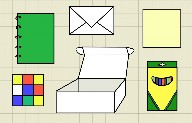

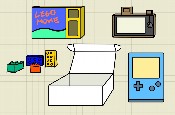
Returning back to the probes themselves, we went into more detail and focused on the design of a single probe. In doing this, we came up with important research questions that a probe would strive to answer. I came up with five main research questions, many of which I had already been thinking about over the course of the project. One of these questions, “where do kids see cobots in relation to them in space?”, especially appealed to me as it simultaneously investigated game design and children’s image of and relationship with cobots.
We also decided to tackle what impact we wanted the final game to have by considering our own game playing history, paying special attention to games that we felt changed an aspect of our lives. I named the Legend of Zelda series as a set of transformative games for me, as I felt that the ingenuity and versatility of its puzzles pushed me to attempt every possible solution before giving up on a goal.
Finally, we brought game design to the cobox probes themselves, creating a game that could be played with just a 5” by 7” probe card and the materials in the cobox. I presented “Cobot Duel,” which follows a probe asking children to design a set of cobots on blank playing cards. I mainly focused on how we could teach the children about cobots through this game; however, I had yet to finalize how we could receive valuable data from the children in return. Some ideas were to have children keep logs of their gameplay or for them to record a review of the game once they finished playing.
Front
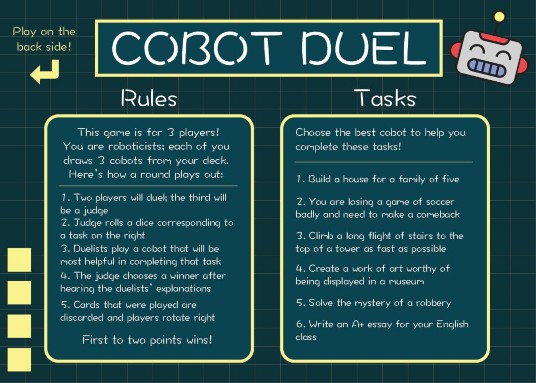
Back
